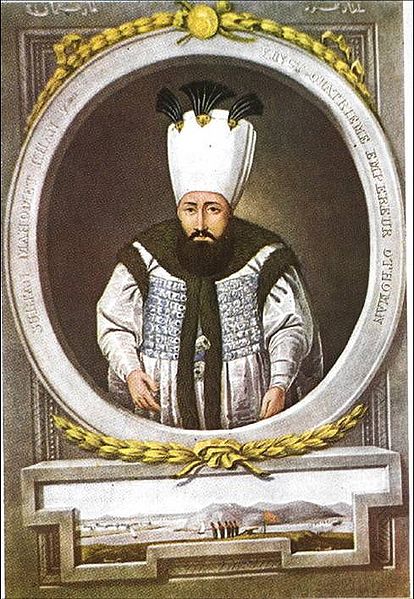<Back to Index>
- Chemist Leopold Gmelin, 1788
- Painter John French Sloan, 1871
- Sultan of the Ottoman Empire Mahmud I the Hunchback, 1696
PAGE SPONSOR

Mahmud I (Ottoman Turkish: محمود اول), called the Hunchback (Kambur) (August 2, 1696 – December 13, 1754) was the Sultan of the Ottoman Empire from 1730 to 1754.
He was born at the Edirne Palace, the son of Mustafa II (1695 – 1703); his mother was Valide Sultan Saliha Sabkati. Mahmud I was the older brother of Osman III (1754 – 57).
On 28 September 1730, Patrona Halil with a small group of fellow Janissaries aroused some of the citizens of Constantinople who opposed the reforms of Ahmet III. Sweeping up more soldiers Halil led the riot to the Topkapı Palace and demanded the death of the grand vizer, Nevşehirli Damat İbrahim Pasha and the abdication of Ahmet III. Ahmet III acceded to the demands, had İbrahim Pasha strangled, and agreed to his nephew, Mahmud, becoming sultan.
Mahmud I was recognized as sultan by the mutineers as well as by court officials but for some weeks after his accession the empire was in the hands of the insurgents. Halil rode with the new sultan to the Mosque of Eyub where the ceremony of girding Mahmud I with the Sword of Osman was performed; many of the chief officers were deposed and successors to them appointed at the dictation of the bold rebel who had served in the ranks of the Janissaries and who appeared before the sultan bare - legged and in his old uniform of a common soldier. A Greek butcher, named Yanaki, had formerly given credit to Halil and had lent him money during the three days of the insurrection. Halil showed his gratitude by compelling the Divan to make Yanaki Hospodar of Moldavia. However, Yanaki never took charge of this office.
The Khan of the Crimea assisted the Grand Vizier, the Mufti and the Aga of the Janissaries in putting down the rebellion. On 24 November 1731, Halil was strangled by the sultan's order and in his presence, after a Divan in which Halil had dictated that war be declared against Russia. His Greek friend, Yanaki, and 7,000 of those who had supported him were also put to death. The jealousy which the officers of the Janissaries felt towards Halil, and their readiness to aid in his destruction, facilitated the exertions of Mahmud I's supporters in putting an end to the rebellion after it had lasted over a year.
The rest of Mahmud I's reign was dominated by wars with Persia, Austria and Russia. Mahmud I entrusted government to his viziers and spent much of his time composing poetry. He died at Topkapı Palace, Constantinople. He married Haja 'Ali - Janab, without issue.